
The NikonD50 is a 6.1-megapixel entry-level digital single-lens reflex camera, sold from June 2005 until November 2006 by Nikon. It was Nikon's first DSLR aimed at the consumer market, and sold for US$899. It uses the Nikon F mount. The D50 is similar to the slightly older D70 using the same CCD sensor, with a slower maximum shutter speed and slightly smaller size; however, it continued to offer the internal focus motor of prior autofocus film and digital SLRs. Future entry-level Nikon DSLRs would eliminate the internal focus motor and require these motors to be in the lenses. Lack of a focus-motor in the camera eliminated the ability to autofocus with late film-era Nikkor AF and AF-D lenses, though these lenses work well on the D50.

The Nikon 50 mm f/1.8D AF Nikkor is one of Nikon's 50 mm lenses. This Double-Gauss lens replaces the 50mm f/1.8 (non-D). A 50 mm prime lens is the normal lens for the 135 film format.

The Nikon F-mount is a type of interchangeable lens mount developed by Nikon for its 35mm format single-lens reflex cameras. The F-mount was first introduced on the Nikon F camera in 1959, and features a three-lug bayonet mount with a 44 mm throat and a flange to focal plane distance of 46.5 mm. The company continues, with the 2020 D6 model, to use variations of the same lens mount specification for its film and digital SLR cameras.

The Nikon DX format is an alternative name used by Nikon corporation for APS-C image sensor format being approximately 24x16 mm. Its dimensions are about 2⁄3 those of the 35mm format. The format was created by Nikon for its digital SLR cameras, many of which are equipped with DX-sized sensors. DX format is very similar in size to sensors from Pentax, Sony and other camera manufacturers. All are referred to as APS-C, including the Canon cameras with a slightly smaller sensor.

The Nikon D40 is Nikon F-mount entry-level digital SLR, announced November 16, 2006 and made until March 2009, when it was succeeded by the Nikon D3000. Compared to its predecessor, the D50, the D40 had several features removed, a few added, and a lower price: US$499.95 ESP as of November 2009 with the 18–55 mm G-II kit lens, positioning it as an entry-level model compared to the D80. The D40x has a 10-megapixel maximum resolution, up from 6 megapixels of the D40 and D50.

The Nikon D60 is a 10.2-megapixel Nikon F-mount digital single-lens reflex camera announced in January 2008. The D60 succeeds the entry-level Nikon D40x. It features the Nikon EXPEED image processor introduced in the higher-end Nikon D3 and D300.

The Nikon D90 is a 12.3 megapixel digital single-lens reflex camera (DSLR) model announced by Nikon on August 27, 2008. It is a prosumer model that replaces the Nikon D80, fitting between the company's entry-level and professional DSLR models. It has a Nikon DX format crop sensor.
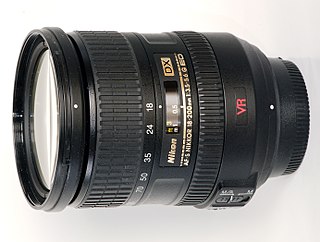
The Nikon AF-S DX VR Zoom-Nikkor 18-200mm f/3.5-5.6G IF-ED is an image stabilised superzoom lens manufactured by Nikon for use on Nikon DX format digital SLR cameras. It provides a single-lens "walk-around" solution for wide-angle through to telephoto shots, as well as close-up photography.
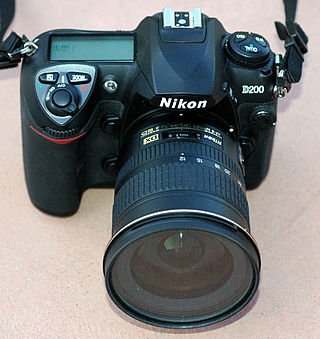
The AF-S DX Zoom-Nikkor 12-24mm f/4G is a lens manufactured by Nikon for use on Nikon DX format digital SLR cameras. It provides an angle of view on a DX format camera similar to that of an 18-35mm lens on a 135 film format camera.
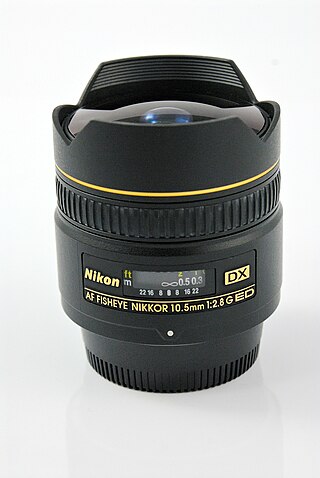
The AF DX Fisheye-Nikkor 10.5mm f/2.8G ED is a fisheye lens manufactured by Nikon for use on Nikon DX format digital SLR cameras. It provides a full 180-degree angle of view on a DX format camera.

The 18-55mm f/3.5-5.6G AF-S Zoom-Nikkor lens is a midrange zoom lens manufactured by Nikon for use on Nikon DX format digital SLR cameras. Often included as a kit lens on entry-level DSLRs, it also can be purchased separately from the camera body. Nikon first introduced the lens in 2005 and has provided three subsequent updates. Following are the four variants as of 2014:

The Nikon D3100 is a 14.2-megapixel DX format DSLR Nikon F-mount camera announced by Nikon on August 19, 2010. It replaced the D3000 as Nikon's entry level DSLR. It introduced Nikon's new EXPEED 2 image processor and was the first Nikon DSLR featuring full high-definition video recording with full-time autofocus and H.264 compression, instead of Motion JPEG compression. It was also the first Nikon DSLR to provide high-definition video recording at more than one frame rate.

The AF-S DX Nikkor 18-105mm f/3.5-5.6G ED VR is a superzoom lens manufactured by Nikon, introduced in August 2008 for use on Nikon DX format digital SLR cameras. This lens is sold as a kit lens for the Nikon D90, Nikon D7000, Nikon D5100, Nikon D5200 and Nikon D3200 cameras, but it also can be purchased separately from the camera body.

The Nikon 1 series is a discontinued camera line from Nikon, originally announced on 21 September 2011. The cameras utilized Nikon 1-mount lenses, and featured 1" CX format sensors.

The Nikon AF-S Zoom-Nikkor 24-120mm f/4G IF-ED VR is a 5x Standard zoom lens with a fixed maximum aperture of f/4 throughout its entire zoom range.

The Nikon AF-S 17-55mm f/2.8 G IF-ED DX was announced in 2004. It is a F-mount professional zoom lens with a constant fast aperture of f/2.8 designed for Nikon DX digital SLR cameras. Nikon have incorporated their Silent Wave Motor for silent auto focusing. The lens is made mostly of metal and the rubber sealed rear mount makes the lens partially dust and water resistant. Dimensions of the lens are 85.5 x 110.5mm. The filter size is 77mm and the lens weighs 755g.
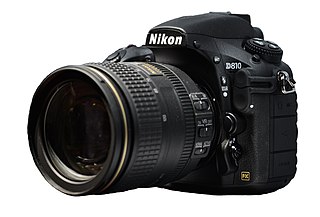
The Nikon D810 is a 36.3-megapixel professional-grade full-frame digital single-lens reflex camera produced by Nikon. The camera was officially announced in June 2014, and became available in July 2014.
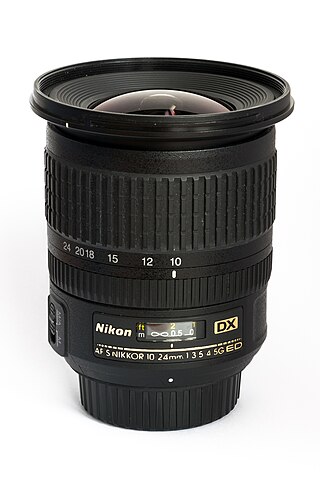
The AF-S DX Zoom-Nikkor 10-24mm f/3.5-4.5G ED is a lens manufactured by Nikon for use on Nikon DX format digital SLR cameras. It provides an angle of view on a DX format camera similar to that of a 15-35mm lens on a 135 film format camera.

Nikon Z-mount is an interchangeable lens mount developed by Nikon for its mirrorless digital cameras. In late 2018, Nikon released two cameras that use this mount, the full-frame Nikon Z 7 and Nikon Z 6. In late 2019 Nikon announced their first Z-mount camera with an APS-C sensor, the Nikon Z 50. In July 2020 the entry level full-frame Z 5 was introduced. In October 2020, Nikon announced the Nikon Z 6II and Nikon Z 7II, which succeed the Z 6 and Z 7, respectively. The APS-C lineup was expanded in July 2021, with the introduction of the retro styled Nikon Z fc, and in October 2021, Nikon unveiled the Nikon Z 9, which effectively succeeds the brand's flagship D6 DSLR. The APS-C lineup was further expanded with the Nikon Z 30, announced at the end of June 2022.



















